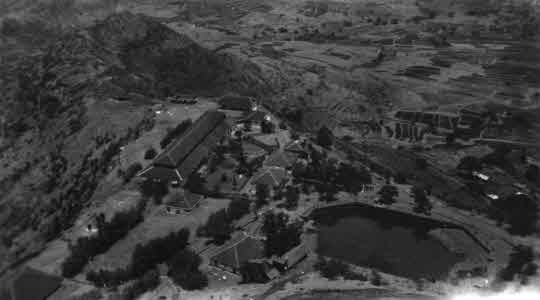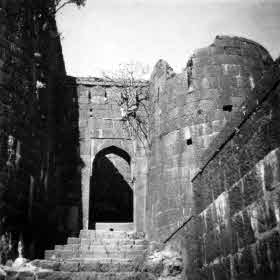The new year starts with me directed to yet another muster of wandering radar mechs. After a long and leisurely train journey steaming along the Western Ghats I arrive in Poona late in the afternoon, stagger out of the station with my gear and manage to thumb a lift on one of the passing trucks bound for the drome.
My advent is badly timed. Everyone is in a state of jitters this day owing to a visit by Field-Marshal Lord Wavell, Viceroy of India, and the wining and dining are still in progress. I am brushed out of the way behind the guardroom door, a scruffy blot on all the spit and polish summoned up for the great occasion.
By the time the Great Man and his vast retinue are safely disposed of, departing in the direction of Bombay in a long cavalcade, I emerge as a minor irritant after a tiring day. They are uncertain where to send me: it states quite clearly on my papers that I am to join 145 Air Ministry Experimental Station, but after a long debate among guardroom personnel it seems that only a couple of clerks have heard of the unit, and one of them is convinced that it has already been disbanded.
I'm not worried by this news, since all I want is a bed for the night, the rest can be sorted out later. Then someone recalls that several other radar mechs arrived that morning, in the middle of the bullshitting prior to the Viceroy's visit, who'd been dumped in a hut on the outer fringes of the camp, far away from the ceremonial area. I am despatched to this billet to see if the inmates can cast any light on my posting.
Things brighten up as soon as I stagger over the threshold with my kit and am greeted by familiar faces. I find a bedspace next to that of Nick whom I've not seen since we parted at Worli, shortly after arrival in India. He's changed somewhat: had his head shaved so I can't resist commenting on the shortest crew-cut I've ever seen. In return, he complains that I've grown so thin he keeps losing sight of me when I turn sideways on.
We dash into Poona to celebrate our reunion in what remains of the evening, filling in the details of our separate lives, drinking a special toast to Jack, the 'old feller', who'd written to us both to say that he's on his way to Bombay with demob group 26, in search of a troopship home...

The RAF ghari, a battered 2-ton Bedford open truck, rattles over the rough ghat road, trailing a long plume of fine ochre dust in the still morning air. There are eight of us crammed in the back with a load of supplies, perched on bedrolls and kitbags, scorching under the hot January sun and grateful for the slight breeze of our passage.
The base camp at Poona is some thirty miles behind us. Directly ahead, looming large as we approach, is our destination, a massive twin-peaked hill, ringed with the ruins of Purandhar fort. This relic of past Maratha wars with the Mogul invaders of the 17th century, today occupied by the British Raj, is the newly established centre of the GEE navigational radar system in the Western Ghats.
When the road abruptly comes to an end in a clearing, the oppressive bulk of Purandhar blots out most of the sky. Our ghari slows, circles leisurely and pulls up at the foot of a narrow track that corkscrews up the hillside at an alarming angle. Piling out, we gratefully stretch cramped limbs, circulate a waterbottle, rinse dust from parched mouths before starting to unload our gear.
A jeep comes bouncing down the hill, horn blaring in welcome. Since it has room for only two people and their baggage on each trip, transfer to the domestic site, located on a spur a third of the way up the hill, proves a lengthy business. Our driver, obviously well-practiced in negotiating the four-wheel-drive on the hairpin bends, zooms up with breathtaking confidence.
I cling to a vibrating seat with one hand, restrain shifting kit with the other, momentarily close my eyes as spinning wheels seem to hang over the void as we reverse on tight corners. It is a relief when we level out, skid past a large water tank, and pull up outside a stone-built bungalow, to be our quarters for the next week or so.

Later that afternoon, showered, fed, and relaxed in clean clothes, we sit on a cool veranda, gazing across the Western Ghats—rugged undulating waves of dusty grays, browns and yellow ochres, shimmering and disappearing into the heat haze. The wind keens through the roof tiles, providing a sound effect that adds to the general impression of having strayed on to the film set of Lost Horizon.
In the evening a pep talk from the officer commanding tells us we are pioneers establishing the GEE navigational chain across India, with operational stations sited north and south of Purandhar, and installations starting up around Delhi and Calcutta, all part of a master plan to provide radar guidance for an airlift through to Japan.
To Japan? It seems that the end of the war is a glitch too minor to cancel the whole shebang and save British tax-payers' money. Sensing a lack of enthusiasm among his audience, the CO dismisses us before awkward non-technical questions can be asked.

The following morning we are escorted up to the technical site, perched on top of one of the peaks of Purandhar, some 4800 feet above sea-level. The place can be reached only on foot, along a track that rambles through the ruins of the old fort, then toils over steep slopes to a last sheer stretch. Here footholds have been carved into the rock and a rope handrail provides a welcome boost, the work of Madrasi sappers who heaved all the apparatus along the route, plus the component parts of a Nissen hut to house it, and then assembled it all, with a 70-foot portable aerial mast, on top. No mean feat.
Once there, we shiver in the chill breeze and, despite the attractions of the awe-inspiring view with a close-up look at the apparently deserted Hindu temple that occupies the opposite peak, are glad to crowd into the shelter of the hut. We are given a general picture of routines, ask questions about the gear, enjoy some hands-on experience. The afternoon passes quickly.
The descent seems easier going but leaves little time to linger and explore the fortifications before dusk. It is only when settling back from a welcome meal that we realise that welfare arrangements have not caught up with this Shangri-la—no books or recreational facilities on offer here. The only diversion proves to be a tiny general store and cafe opened by an enterprising Portuguese Indian on occasional evenings.
This is not one of them. We also learn that our movements are restricted. Parts of the site are out of bounds because internees are still held there and non-fraternisation is the order of the day.
 In off-duty moments during our stay we clamber up the shrubby terrain to visit the ruins, one of a complex of hill forts built in the Deccan some three hundred years ago, when the legendary Maratha leader Shivaji defied the might of Aurangzeb, the last of the Moghul emperors. In off-duty moments during our stay we clamber up the shrubby terrain to visit the ruins, one of a complex of hill forts built in the Deccan some three hundred years ago, when the legendary Maratha leader Shivaji defied the might of Aurangzeb, the last of the Moghul emperors.
We never manage to make a full circuit of the blackened stone curtain walls that wind round the hill for more than twenty miles, with six rugged bastions guarding the remains of the three main gates. Long stretches are remarkably well preserved, while other sections have almost disappeared. The builders of our present domestic quarters, sometime last century, obviously pillaged the fortifications as a source of ready-to-hand construction material.
But these preoccupations with India's martial past are terminated with the news that we are to be sent to Mahableshwar, a hill station some fifty miles south, to receive detailed instruction on GEE operation at the 'slave' station established there. ■
© Harry Turner, 1998. |





 In off-duty moments during our stay we clamber up the shrubby terrain to visit the ruins, one of a complex of hill forts built in the Deccan some three hundred years ago, when the legendary Maratha leader Shivaji defied the might of Aurangzeb, the last of the Moghul emperors.
In off-duty moments during our stay we clamber up the shrubby terrain to visit the ruins, one of a complex of hill forts built in the Deccan some three hundred years ago, when the legendary Maratha leader Shivaji defied the might of Aurangzeb, the last of the Moghul emperors.